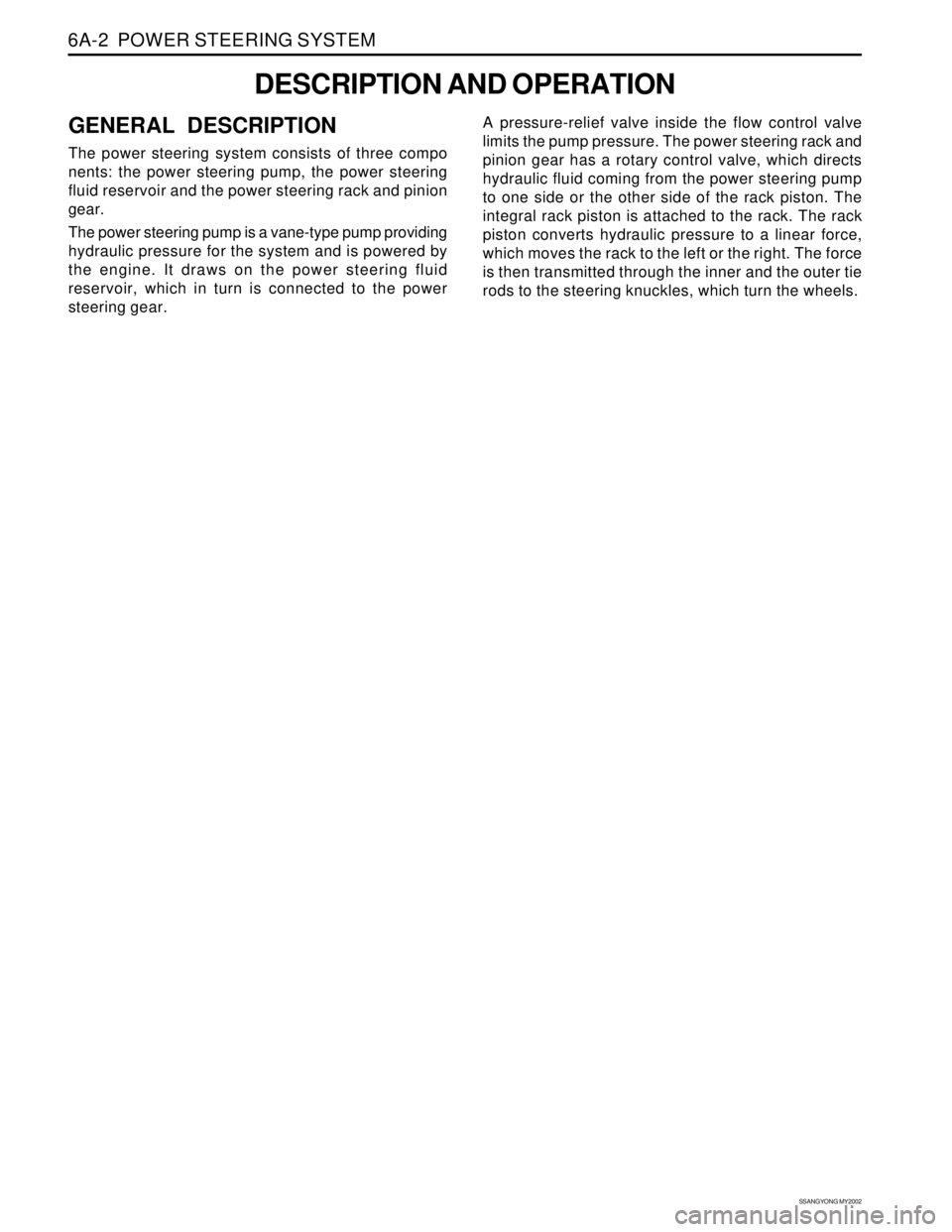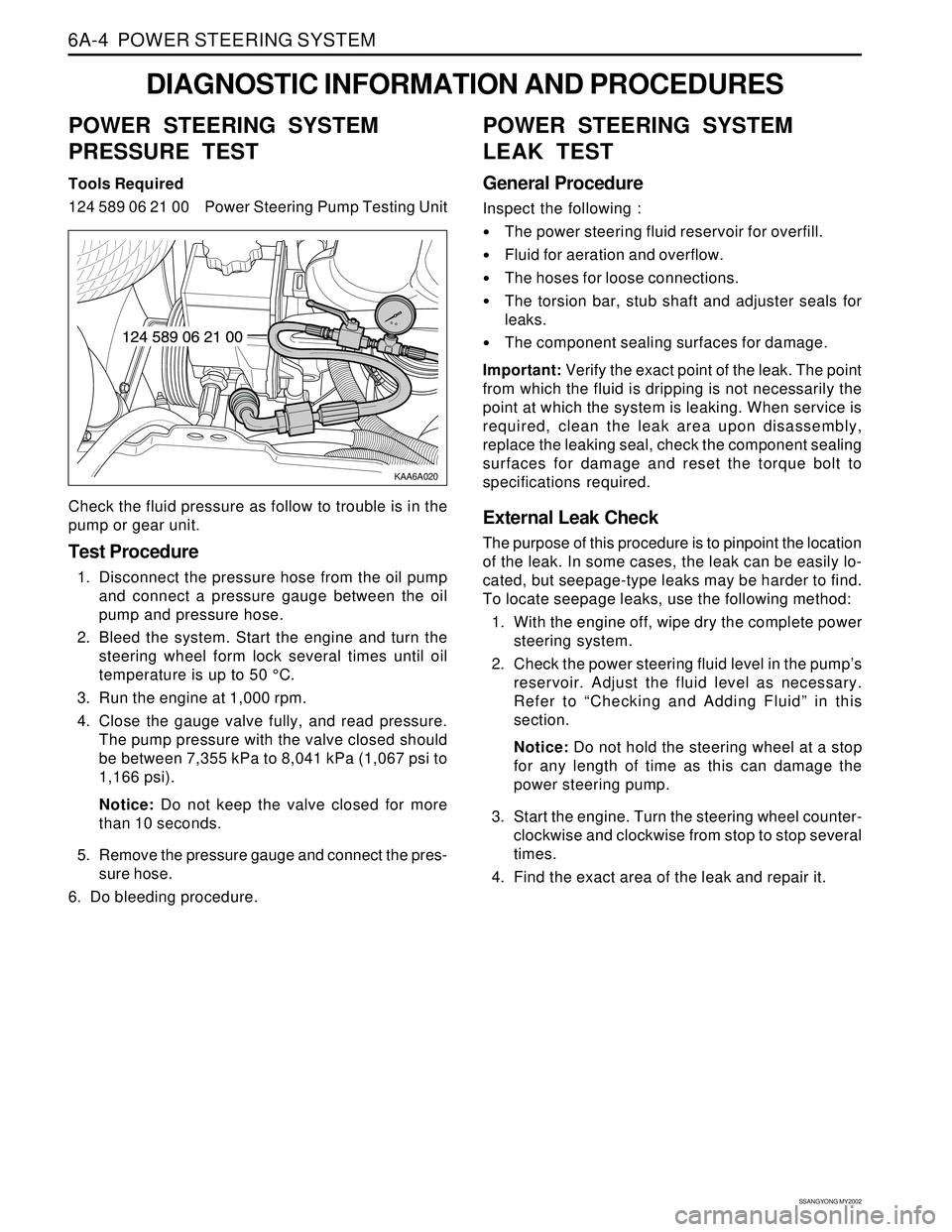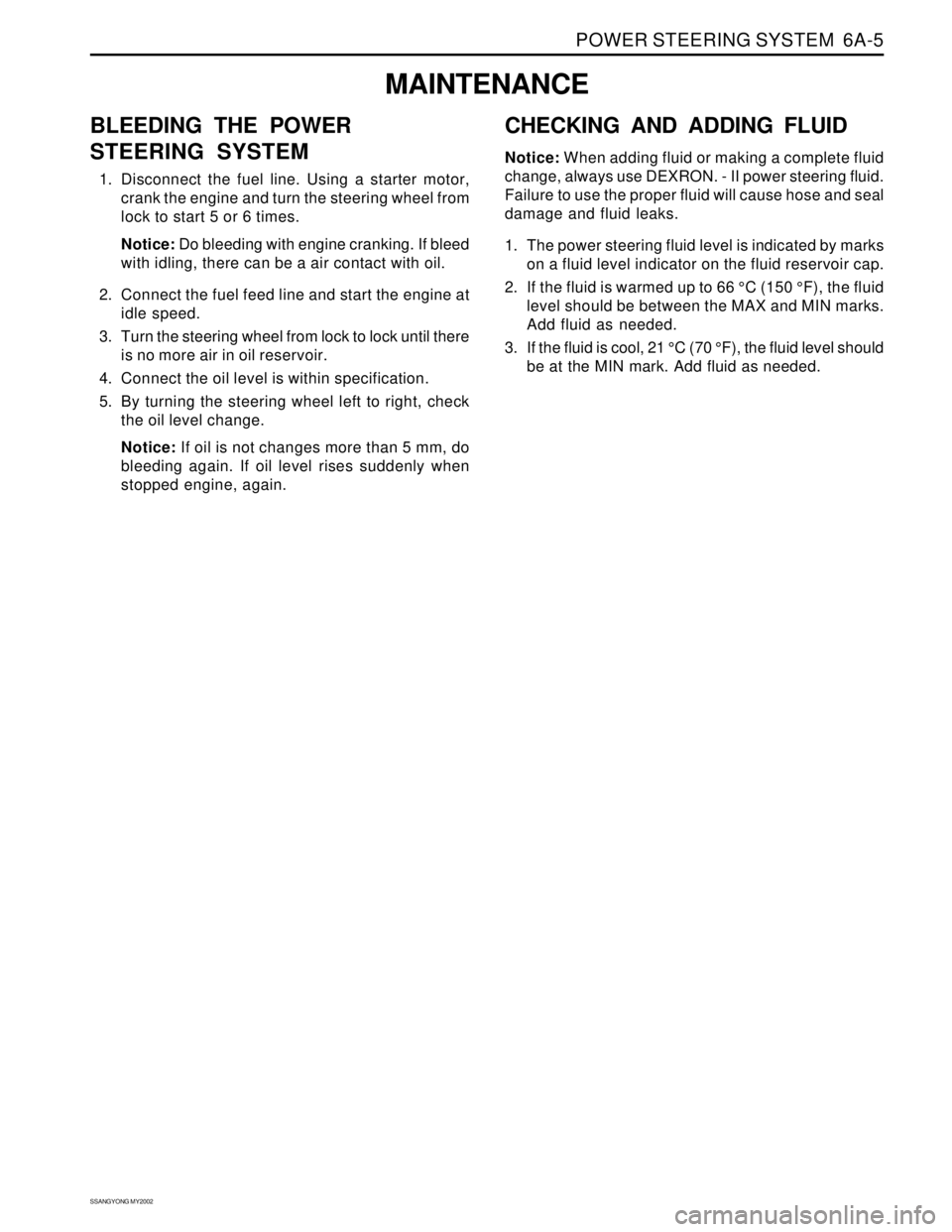engine SSANGYONG KORANDO 1997 Service Repair Manual
[x] Cancel search | Manufacturer: SSANGYONG, Model Year: 1997, Model line: KORANDO, Model: SSANGYONG KORANDO 1997Pages: 2053, PDF Size: 88.33 MB
Page 1453 of 2053

SSANGYONG MY2002
6A-2 POWER STEERING SYSTEM
DESCRIPTION AND OPERATION
GENERAL DESCRIPTION
The power steering system consists of three compo
nents: the power steering pump, the power steering
fluid reservoir and the power steering rack and pinion
gear.
The power steering pump is a vane-type pump providing
hydraulic pressure for the system and is powered by
the engine. It draws on the power steering fluid
reservoir, which in turn is connected to the power
steering gear.A pressure-relief valve inside the flow control valve
limits the pump pressure. The power steering rack and
pinion gear has a rotary control valve, which directs
hydraulic fluid coming from the power steering pump
to one side or the other side of the rack piston. The
integral rack piston is attached to the rack. The rack
piston converts hydraulic pressure to a linear force,
which moves the rack to the left or the right. The force
is then transmitted through the inner and the outer tie
rods to the steering knuckles, which turn the wheels.
Page 1455 of 2053

SSANGYONG MY2002
6A-4 POWER STEERING SYSTEM
KAA6A020
DIAGNOSTIC INFORMATION AND PROCEDURES
POWER STEERING SYSTEM
PRESSURE TEST
Tools Required
124 589 06 21 00 Power Steering Pump Testing Unit
Check the fluid pressure as follow to trouble is in the
pump or gear unit.
Test Procedure
1. Disconnect the pressure hose from the oil pump
and connect a pressure gauge between the oil
pump and pressure hose.
2. Bleed the system. Start the engine and turn the
steering wheel form lock several times until oil
temperature is up to 50 °C.
3. Run the engine at 1,000 rpm.
4. Close the gauge valve fully, and read pressure.
The pump pressure with the valve closed should
be between 7,355 kPa to 8,041 kPa (1,067 psi to
1,166 psi).
Notice: Do not keep the valve closed for more
than 10 seconds.
5. Remove the pressure gauge and connect the pres-
sure hose.
6. Do bleeding procedure.
POWER STEERING SYSTEM
LEAK TEST
General Procedure
Inspect the following :
The power steering fluid reservoir for overfill.
Fluid for aeration and overflow.
The hoses for loose connections.
The torsion bar, stub shaft and adjuster seals for
leaks.
The component sealing surfaces for damage.
Important: Verify the exact point of the leak. The point
from which the fluid is dripping is not necessarily the
point at which the system is leaking. When service is
required, clean the leak area upon disassembly,
replace the leaking seal, check the component sealing
surfaces for damage and reset the torque bolt to
specifications required.
External Leak Check
The purpose of this procedure is to pinpoint the location
of the leak. In some cases, the leak can be easily lo-
cated, but seepage-type leaks may be harder to find.
To locate seepage leaks, use the following method:
1. With the engine off, wipe dry the complete power
steering system.
2. Check the power steering fluid level in the pump’s
reservoir. Adjust the fluid level as necessary.
Refer to “Checking and Adding Fluid” in this
section.
Notice: Do not hold the steering wheel at a stop
for any length of time as this can damage the
power steering pump.
3. Start the engine. Turn the steering wheel counter-
clockwise and clockwise from stop to stop several
times.
4. Find the exact area of the leak and repair it.
Page 1456 of 2053

POWER STEERING SYSTEM 6A-5
SSANGYONG MY2002
BLEEDING THE POWER
STEERING SYSTEM
1. Disconnect the fuel line. Using a starter motor,
crank the engine and turn the steering wheel from
lock to start 5 or 6 times.
Notice: Do bleeding with engine cranking. If bleed
with idling, there can be a air contact with oil.
2. Connect the fuel feed line and start the engine at
idle speed.
3. Turn the steering wheel from lock to lock until there
is no more air in oil reservoir.
4. Connect the oil level is within specification.
5. By turning the steering wheel left to right, check
the oil level change.
Notice: If oil is not changes more than 5 mm, do
bleeding again. If oil level rises suddenly when
stopped engine, again.
MAINTENANCE
CHECKING AND ADDING FLUID
Notice: When adding fluid or making a complete fluid
change, always use DEXRON. - II power steering fluid.
Failure to use the proper fluid will cause hose and seal
damage and fluid leaks.
1. The power steering fluid level is indicated by marks
on a fluid level indicator on the fluid reservoir cap.
2. If the fluid is warmed up to 66 °C (150 °F), the fluid
level should be between the MAX and MIN marks.
Add fluid as needed.
3. If the fluid is cool, 21 °C (70 °F), the fluid level should
be at the MIN mark. Add fluid as needed.
Page 1458 of 2053

POWER STEERING SYSTEM 6A-7
SSANGYONG MY2002
KAA6A050
KAA6A060
4. Disconnect the return line pipe from the power
steering gear outlet.
Installation Notice
KAA6A070
5. Disconnect the pressure line pipe from the power
steering gear inlet.
Installation Notice
POWER STEERING PUMP HOSES
AND PIPES
Removal and Installation Procedure
1. Remove the battery. Refer to Section 1E, Engine
Electrical.
2. Siphon the power steering fluid from the fluid reser-
voir.
3. Disconnect the pressure line pipe from the outlet
connection on the power steering pump and return
hose from the inlet connection on the power
steering fluid reservoir.
Installation Notice
Tightening Torque 44 Nm (33 lb-ft)
Tightening Torque 17 Nm (13 lb-ft)
Tightening Torque 17 Nm (13 lb-ft)
Page 1465 of 2053

SSANGYONG MY2002
6B-4 POWER STEERING PUMP
KAA6B010
REPAIR INSTRUCTIONS
ON-VEHICLE SERVICE
SERPENTINE ACCESSORY DRIVE
BELT
Removal and Installation Procedure
1. Remove the electric cooling fan. Refer to Section
1D, Engine Cooling.
2. Use a wrench to turn the tensioner bolt clockwise,
compressing the tensioner, and releasing the
tension on the serpentine accessory drive bolt.
KAA6B020
3. Remove the serpentine accessory drive belt.
Page 1466 of 2053

POWER STEERING PUMP 6B-5
SSANGYONG MY2002
KAA6B050
5. Remove the power steering pump assembly
mounting bolts.
Installation Notice
KAA6B040
3. Siphon the power steering fluid from the fluid reser-
voir.
4. Disconnect the pressure line pipe from the outlet
connectionon the power steering pump and return
hose from the inlet connection on the power
steering fluid reservoir.
Installation Notice
Tightening Torque 44 Nm (33 lb-ft)
KAA6B010
POWER STEERING PUMP
ASSEMBLY
Removal and Installation Procedure
1. Remove the battery. Refer to Section 1E, Engine
Electrical.
2. Use a wrench to turn the tensioner bolt clockwise,
compressing the tensioner, and releasing the
tension on the serpentine accessory drive belt.
Loosen the serpentine accessory drive belt.
Tightening Torque 25 Nm (17 lb-ft)
6. Remove the power steering pump assembly.
Page 1473 of 2053

POWER STEERING GEAR 6C-5
SSANGYONG MY2002
Check the power steering pump for insufficient pres-
sure.
Check the power steering pump flow control valve for
sticking and improper operation.
Check the power steering pump serpentine belt for
slippage.
Check for air contamination in the power steering
system.ChecksActionReplace the power steering pump.
Replace the power steering pump.
Tighten the power steering serpentine belt.
Bleed the power steering system
Steering Surges or Jerks When Turning with Engine Running
Check for air contamination in the power steering
system.
Check the power steering pump serpentine belt for
looseness.ChecksActionBleed the power steering system.
Tighten the power steering serpentine belt.
Steering Vibrates During Low Speed or Static Steering
Excessive Wheel Kickback or Loose Steering
Check for air contamination in the power steering
system.
Check the wheel bearings for wear or damage.
Check the steering gear mounting for improper instal-
lation.
Check the intermediate shaft joints for improper
Installation.
Check the outer tie rods and the ball joints for
looseness.ChecksActionBleed the power steering system.
Replace the wheel bearings.
Tighten the steering gear mounting bracket nuts and
bolts.
Adjust the intermediate shaft between the steering
gear and the steering column. Replace the intermedi-
ate shaft.
Tighten the tie rods and the ball joints. Replace the tie
rods and the ball joints.
Hard Steering or Lack of Assist (Especially During Parking)
Check the intermediate shaft joints for improper
installation.
Check the power steering pump flow control valve for
sticking and improper installation.
Check the power steering pump for insufficient pressure.
Check the power steering pump for internal leaks.
Check for a loose or a worn intermediate shaft.
Check the power steering pump serpentine belt tension.ChecksActionAdjust the intermediate shaft between the steering gear
and the steering column. Replace the coupling flange.
Replace the power steering pump.
Replace the power steering pump.
Replace the power steering pump.
Tighten the intermediate shaft. Replace the intermedi-
ate shaft, as needed.
Tighten the power steering serpentine belt.
Page 1474 of 2053

SSANGYONG MY2002
6C-6 POWER STEERING GEAR
POWER STEERING RACK AND
PINION GEAR BENCH TESTING
Removal and Installation Procedure
Notice: Pressure checks or pressure and flow checks
may also be conducted using this setup.
1. Disconnect and remove the power steering gear.
Refer to “Rack and Pinion Assembly” in this
section.
2. Place the power steering gear on a bench next to
the vehicle.
3. Disconnect the pressure line at the point where the
hose connects to the pipe. Extend this line to reach
the power steering gear on the bench.
4. Disconnect the return line from the power steering
fluid reservoir. Extend this line to reach the power
steering gear on the bench.
5. Connect the power steering pipes to the power
steering gear.
6. Start the engine and allow it to idle for 10 seconds.
7. Check the power steering fluid level. Refer to
Section 6A, Power Steering System.
8. Start the engine and turn the rack and pinion stub
shaft a full turn in each direction. Hold the shaft
against each stop for 5 seconds.
9. Inspect for possible leak points. Refer to Section
6A, Power Steering System.
Installation Procedure
1. Stop the engine.
2. Disconnect the power steering pipes from the power
steering gear.
KAA6C020
3. Remove the extensions and reconnect the pressure
and return lines.
4. Install and connect the power steering gear. Refer
to “Rack and Pinion Assembly” in this section.
5. Start the engine and allow it to idle for 10 seconds.
6. Check the power steering fluid level. Refer to
Section 6A, Power Steering System.
STRAIGHT-AHEAD CHECK
After all the necessary operations on the steering gear
are completed (removing and installing, disassembling
and assembling), check the exact straight-ahead posi-
tion of the steering in each case.
With the vehicle on the floor, place the steering wheel
in the straight-ahead position. Mark the centerline of
both tires on the floor. Turn the steering wheel all the
way to the right and mark the new centerline of both
tires on the floor.
Page 1490 of 2053

SSANGYONG MY2002
6E-4 POWER STEERING AND COLUMN
DIAGNOSTIC INFORMATION AND PROCEDURES
STEERING WHEEL FREEPLAY
INSPECTION
KAA6E020
Inspection Procedure
1. Start the engine and set the wheels in straight
ahead position.
2. Slightly move the steering wheel to the left and
right and measure steering wheel free play when
the front wheel is start to move.
Notice: If exceeds specification, the steering
column shaft connections and steering linkage
clearance. Replace or repair if necessary.
StandardMax. 30 mm
STEERING EFFORT INSPECTION
KAA6E030
Inspection Procedure
1. Place a vehicle on the paved flat ground with front
wheels in a straight ahead position.
2. Start the engine and run it at 1,000 rpm.
3. Using a scale, measure the steering effort in both
directions.
Notice : The difference in steering effort of left
and right should be within 0.6 kg.
StandardMax. 3.0 kg
Page 1502 of 2053

SECTION 7A
HEATING AND VENTILATION SYSTEM
CAUTION: The cooling system is pressurized when hot. Injury can result from removing the coolant reservoir
cap before the engine is sufficiently cool.
TABLE OF CONTENTS
Description and Operation ................................7A-2
Heating and Ventilation System .........................7A-2
Components Locator ..........................................7A-3
Heater System ...................................................7A-3
Diagnostic Information and Procedures ..........7A-4
Heater System ...................................................7A-4
Blower Electrical ................................................7A-8
Mode Controls Do Not Work .............................7A-10
Air Source Selection Not Controlled ..................7A-12
Temperature Controls Do Not Work ..................7A-13
Too Much Heat .................................................7A-14
Blower Noise ....................................................7A-16
Repair Instructions ............................................7A-18
On-Vehicle Service..............................................7A-18
Temperature Control Cable Adjustment ............7A-18
Controller Assembly and Temperature
Control Cable .................................................7A-18
Control Assembly Knob Lighting ......................7A-19Air Intake Door Actuator ...................................7A-19
Mode Control Door Actuator .............................7A-20
Heater/Air Distributor Case Assembly ..............7A-20
Blower Motor ....................................................7A-21
Blower Resistor ................................................7A-22
Blower Unit .......................................................7A-22
Heater Inlet Hose ..............................................7A-23
Heater Outlet Hose ...........................................7A-23
Heater Core......................................................7A-24
Rear Heater Duct ..............................................7A-24
Air Filter ............................................................7A-24
Specifications .................................................... 7A-25
Heater Temperature Specification .....................7A-25
Heater Unit .......................................................7A-25
Fastener Tightening Specification .....................7A-25
Schematic and Routing Diagrams ................... 7A-26
Non - A/C Wiring Diagram ................................7A-26
Airflow Through Vents .......................................7A-28